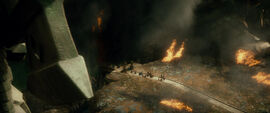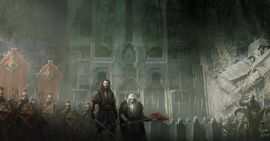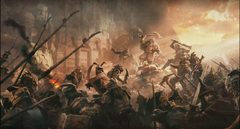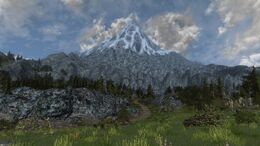Where Is the Lonely Mountain in Relation to Mordor
The Lonely Mountain, known in Sindarin as Erebor, referred to both a mountain in northern Rhovanion and the subterranean Dwarven city contained within it. In the latter half of the Third Age, it became the greatest Dwarf city in Middle-earth.
It was located northeast of Mirkwood, near the Grey Mountains, and was the source of the River Running.
Contents
- 1 History
- 1.1 Third Age
- 1.1.1 Under Siege
- 1.1.2 Quest for Erebor
- 1.1.3 War of the Ring
- 1.1.3.1 Battle of Dale
- 1.2 Fourth Age
- 1.1 Third Age
- 2 Portrayal in adaptations
- 2.1 The Hobbit film trilogy
- 2.1.1 The Quest of Erebor
- 2.1.2 Battle of Five Armies
- 2.1.3 Aftermath
- 2.2 Video games
- 2.1 The Hobbit film trilogy
- 3 Gallery
- 4 Translations
- 5 References
History
Third Age
Durin's Folk discovered the mineral wealth of the Lonely Mountain during the Second Age, but the colony only came into its own after the fall of Khazad-dûm. In TA 1999 King Thráin I led his people there and became King under the Mountain. In time, they became very rich and amassed a large amount of gold and treasure which included the jewel known as the Arkenstone. Thráin I used the Arkenstone as a symbol of his rule, and his sons and grandsons under him who were to follow.
For two-hundred and eleven years the kingdom advanced, expanded and prospered until Thorin I abandoned it to join his kin in the Grey Mountains in TA 2210. The Lonely Mountain was abandoned for three-hundred and eighty years. However, the Dwarves of the Grey Mountains began to be attacked by the dragons that still lived in those mountains, and became embroiled in a costly war against them, which forced the Dwarves to abandon the Grey Mountains in TA 2590. They went their separate ways: Grór and his followers settled in the Iron Hills, and Thrór with his followers went to the Lonely Mountain.[2]
Under Siege

Erebor became the lair of Smaug
While Thorin Oakenshield was out hunting one day in TA 2770, Smaug flew in from the northern mountains and attacked the Lonely Mountain. After laying waste to both Erebor and the neighbouring town of Dale, Smaug made the mountain his domain and hoarded the kingdom's wealth for himself. Thrór, his son Thráin and several companions escaped through a Side-door. For many years thereafter the Dwarves lived in exile first in Dunland and then the Blue Mountains. After a time Thráin II grew restless and set out with a band of companions in TA 2841 to return to the mountain, but was harassed by Orcs and Wargs the whole way. Thráin vanished one morning four years later and the attempt was abandoned.
Then seemingly by chance, Gandalf met Thorin in Bree, where together they planned to reclaim the mountain.[3]
Quest for Erebor
In TA 2941, Bilbo Baggins and Thorin's company traveled to the Lonely Mountain to regain the treasure Smaug had stolen. Set into the side of the mountain was a secret door, five feet high and wide enough for three to walk through abreast. Gandalf had managed to obtain the door's key and a map to its location from Thráin II, which could be found only when the setting sun and the last moon of autumn (also known as Durin's Day) would shine their light upon the keyhole. It took many days to find the door, and luckily for Thorin and Company, they did arrive on Durin's Day and were able to enter the mountain.
Smaug was eventually slain, shot out of the sky by a well-aimed arrow at his only weak spot by Bard the Bowman, a man of Lake-town and a descendant of Girion, the last Lord of Dale. He was later declared king of the restored Kingdom of Dale. Thorin thus reclaimed the mountain, but the Elves of Mirkwood and Men of Lake-town sought a part of the treasure, which Thorin refused to share. Dáin Ironfoot came to Thorin's aid, and the three races almost broke into war, until a host of Orcs and wolves attacked, eager to break the strength of all three peoples. Dwarves, Elves, and Men, together with the Eagles, battled the Orcs in what became known as the Battle of Five Armies. During the battle, Thorin was mortally injured, and the titles of King under the Mountain and King of Durin's Folk passed to Dáin.
War of the Ring
Battle of Dale
The demise of Smaug was not to be the last of the Lonely Mountain's many troubles. In TA 3019 on the 17th of March, a horde of Easterling soldiers from Rhûn swarmed over the Redwater river, opening up a new front in the northern theater of the War of the Ring. The Men of Dale fell back to the the protection of the Lonely Mountain.

Kings Brand and Dáin ready to defend their kingdoms
Dwarves and Men fought a pitched battle against the invaders, in which Dáin and Brand, the King of Dale, were killed. The impenetrable gates and walls of the Lonely Mountain, buttressed and secured with advanced, complex, and resilient Dwarven stonecraft and smithwork, easily withstood the siege equipment of the Easterlings. The many years spent improving the Lonely

The last resistance against the forces of Sauron
Mountain's defenses had paid off, and the Easterlings were unable to gain entry. Following the news of the destruction of the One Ring and the fall of Sauron, the Dwarves and Men of Dale sortied and routed the besieging army.
Fourth Age
As Dáin was killed during the War of the Ring, lordship of Erebor passed to his son Thorin III Stonehelm, who ruled well into the Fourth Age. During this time, Dwarves from the Lonely Mountain helped rebuild cities in Gondor and the fortress of the Hornburg, and some went to the newly established Dwarven colony in the Glittering Caves where Gimli was lord. Eventually an expedition was led from the mountain to reclaim the Longbeards' ancestral home of Khazad-dûm.
Portrayal in adaptations
The Hobbit film trilogy
Peter Jackson's The Hobbit trilogy (2012-2014) featured computer-generated shots of the Lonely Mountain, Dale, and other Dwarven cities.
Erebor is seen in flashbacks as the elderly Bilbo Baggins recounts the beginnings of his adventure, along with Dale.
Erebor is described as the stronghold and subterranean realm of Thror, King under the Mountain, most powerful among the Dwarf lords and the strongest Dwarf kingdom in Middle-earth beneath the Lonely Mountain and it's ruler being considered the lord of all Dwarf mansions. Alongside it's neighbor, Dale, a great prosperous city of Men and Esgaroth, prosperity became commonplace in the Dwarven realm. Eventually, the Dwarves of Erebor uncover riches beneath the earth, making their realm into a great kingdom, and benefiting Dale. While the Dwarves are mining, the Arkenstone is discovered, which Thror proclaims the King's Jewel, while forging a golden statue in his likeness.
Succumbing to greed, Thror denies his potential ally, Thranduil, the Elven king of the Woodland Realm, ownership of the the White Gems, which creates a rift between their peoples, with Thranduil warning the Dwarf lord of his vast horde of gold luring evil in the future. With Thror losing himself in his greed, he spends longer time periods in his lower halls with his gold, must to his grandson's fear. The Elven king's prediction came to be true as the vast wealth attracts the dragon, Smaug, noticed by Thorin, who lays waste to the city of Dale, unhindered by Girion, despite the use of Black Arrows. Thorin rescues Balin from incineration and rallies his troops for a confrontation with Smaug, who bests the marshaled army. Thorin survives and rescues his grandfather, who in avarice, fled to his treasure hoard, losing the Arkenstone.
Thorin leads an exodus of Dwarves from their stolen homeland, Thorin sees Thranduil and his soldiers approaching, pleading for help. Thranduil, bitter over his rift with Thror, withdraws alongside his forces, making Thorin hateful of Elves for a long period. Thorin leads his people across Rhovanion and into Dunland, where he works as a blacksmith to provide for his people and leads them into the Blue Mountains. But he never got over the events that transpired with his home, lacking forgetfulness and forgiveness over it.
After losing Erebor, the Dwarves became a nomadic people, residing in human settlements. After their losses in the Battle of Moria, with both the king and the prince gone, Thorin led his people into the Blue Mountains, where they ultimately established a new colony. Many accepted the Blue Mountains as their new home, with Thorin's nephews, Kili and Fili born in there, several viewed Erebor as their true home.
Thorin later pursued rumors of his father being spotted in the wild near Dunland, after disappearing in the conflict in Moria against Azog. Clinging to false hopes, he went searching in vain. Unknown to him, Azog, having survived his duel with Thorin, set a price on his head, spreading the message through the wild. Gandalf found a copy of this, and showed it to Thorin to Bree. His suspicions of darkness rising aroused, Gandalf convinced the Dwarf exilarch to undertake a quest to reclaim Erebor. The reluctant and mistrustful Dwarf prince, stated he requires the Arkenstone to exert his authority over the other Dwarf Lords and marshal an army against Smaug. Gandalf offered to call upon a burglar to help sneak it past the dragon. Thorin called upon his people, and twelve of his kinsmen answered. Gandalf bade them to the burglar's home, which he marked. Meanwhile, Thorin sent a call for emissaries from all seven Dwarf kingdoms to come to his halls, asking their aid in the Quest of Erebor, which he was denied. Thorin was taken aback by Gandalf's suggestion to use a Hobbit as the burglar, but nonetheless agreed to meet him. However, Thorin's attempts were unsuccessful and instead, settled with the other twelve dwarves who answered his call.
The Quest of Erebor
In TA 2941, Bilbo Baggins and Thorin's company traveled to the Lonely Mountain to regain the treasure Smaug had stolen. Set into the side of the mountain was a secret door, five feet high and wide enough for three to walk through abreast. Gandalf had managed to obtain the door's key, which fit a key hole which could be found only when the setting sun and the last moon of autumn (also known as Durin's Day) were in the sky would the light shine upon the keyhole. Bilbo entered the mountain himself, stumbling upon the dragon Smaug, who he met for the first time. The company tried to eliminate Smaug themselves by burying him under molten gold made in the forges; however, the trap failed.
Smaug was enraged by the actions of Thorin and Company and, to punish them, set his eyes on destroying Lake-town and its citizens. When Smaug came to the city, the Master packed up his treasure and left by boat. He was however crushed under Smaug's carcass when Bard slew him, but not before the dragon conflagrated the whole of the town and many of its people.
Battle of Five Armies
The survivors fled by boat to the shore, where they lived in tents before Bard came and ordered them to leave for the ruins of Dale. Thranduil came to his aid, but only with the intention of recruiting the people of Lake-town to his cause of forcing Thorin to surrender some of the riches of the mountain to him. Bard convinced Thranduil he could reason with Thorin without the need to go to war. However, Thorin, overcome by the gold sickness, refused, sending Bard away. Without any other option, Bard and Thranduil joined forces, leading to a small siege around Erebor. During the night, they were visited by Bilbo, who Bard recognized from Lake-town, who gave them the Arkenstone, believing that they could use it to their own advantage.Meeting at the front gate, Thranduil and Bard ransomed the Arkenstone; however, Thorin did not believe it was the stone he was searching for until Bilbo revealed it was the true Arkenstone, revealing the truth. Enraged, Thorin nearly killed the hobbit, believing it was betrayal until Gandalf intervened, demanding Thorin release Bilbo and remarking that set an ill example as King under the Mountain. The dwarf king released Bilbo but banished him from Erebor, refusing to ever accept help from Wizards or Hobbits again.
Dain Ironfoot arrived at that moment, and a small skirmish ensued among the Dwarves, Men and Elves. Gandalf attempted to reason with Dain, telling them they were all fighting the wrong enemy and the true one was heading its way, led by Azog, who was sent to take Erebor for his master, Sauron because of its' strategic position. However, the elves and men began to fight the dwarves, who appeared to have the upper hand until three Were-worms dug through the ground, as the Forces of Dol Guldur emerged. To Dáin, Thranduil, and Bard's horror, Gandalf had spoken the truth upon watching Azog's armies emerge.
The three Free Peoples almost did battle with one another, but then Orcs attacked and the Dwarves, Elves, and Men joined ranks together with the Great Eagles against the Orcs, in what became known as the Battle of the Five Armies. The battle extended to the city of Dale, meant to serve as a distraction. As Dáin and his people fought, they were lost without Thorin's absence.
After Thorin overcame his gold sickness, the Dwarves emerged from the mountain, the company joined in the Battle of the Five Armies. Thorin decided to lead an assault towards Azog's command tower in Ravenhill. Dwalin, Balin, Fili and Kili commandeered a Dwarven war chariot, following Thorin through the frozen channel of the River Running. Azog, intending the entire battle as a trap for Thorin, tried to stop his friends from reaching him, sending ogres, a Troll and Wargs after them. Bofur, astride a Troll, managed to help them against the Troll, but the Wargs forced Dwalin, Fili and Kili to take the mounts and leave Balin behind to fend off his foes while they went to Ravenhill.
During the showdown between Azog and Thorin, the Eagles, Radagast and Beorn arrived, quickly dispatching the Gundabad army. During the battle, both Thorin and Azog mortally wounded each other, resulting in their deaths.
Aftermath
In the wake of the battle, a funeral was held for Thorin Oakenshield, Fíli and Kíli, with members of Thorin and Company, Beorn and Radagast in attendance while those in the city of Dale honored those who had fallen in Battle. The mountain was garrisoned by the Dwarves of the Iron Hills and portions of its wealth were distributed to various parties like the Men of the Lake, who set up permanent residence in Dale and elected Bard as the new Lord of Dale.
The Elves of Mirkwood stayed just a short time to receive their share of the treasure before returning to their forest homeland. With Thorin and his immediate family members dead, Dain succeeded him as King under the Mountain. His job done, Bilbo Baggins parted ways with the Company and returned home to the Shire with Gandalf with his secret magic ring always close at hand.
Video games

Erebor in The Lord of the Rings Online
In The Lord of the Rings Online, after a minor appearance depicting the Siege of Erebor, Erebor proper was added in 2018 as part of Eryn Lasgalen and the Dale-lands. After the breaking of the siege, it is now ruled by King Thorin III Stonehelm who must deal with some of the enemy's army still remaining near his lands. Other than the main hall of Erebor, players can also visit the living quarters, the burial tombs as well as several hidden chambers within the Mountain.
Gallery
Translations
| Foreign Language | Translated name |
| Afrikaans | Eensame Berg |
| Albanian | Mal i Vetmuar |
| Arabic | الجبل الوحيد |
| Armenian | Միայնակ լեռ |
| Azerbaijani | Tənha Dağ |
| Belarusian Cyrillic | Адзінокая Гара (Lonely Mountain) Эрэбар (Erebor) |
| Bengali | লোনলি মাউন্টেন |
| Bosnian | Usamljena planina |
| Bulgarian Cyrillic | Самотна планина (Lonely Mountain) Еребор (Erebor) |
| Burmese | အထီးကျန်တောင်ကြီးတောင်ငယ် |
| Cambodian | ភ្នំឯកោ |
| Cebuano | Mingaw nga bukid |
| Chinese (Continental) | 孤山 |
| Chinese (Hong Kong) | 孤山 |
| Catalan | Muntanya Solitària |
| Croatian | Usamljena planina |
| Czech | Osamělá hora |
| Danish | Det Ensomme Bjerg |
| Dutch (Netherlands And Belgian) | Eenzame Berg |
| Esperanto | Soleca Monto |
| Estonian | Üksildane Mägi |
| Basque | Mendi Bakartia |
| Filipino | Nag-iisang Bundok |
| Finnish | Yksinäinen vuori |
| French | Mont Solitaire |
| Frisian | Iensume Berch |
| Galician | Montaña Solitaria |
| Georgian | ეული მთა (Lonely Mountain) ერებორი (Erebor) |
| German | Einsamer Berg |
| Greek | Μοναχικό Βουνό |
| Gujarati | લોન્લી માઉન્ટેન |
| Hawaiian | Mehameha Mauna |
| Hebrew | (Erebor) רבור (Lonely Mountain) ההר הבודד |
| Haitian Creole | Mòn sèl |
| Hindi | सुुनसान पर्वत |
| Hmong | Roob kho siab |
| Hungarian | Magányos Hegy |
| Icelandic | Einmanna fjall |
| Indonesian | Gunung Sunyi |
| Irish Gaelic | Sliabh Uaigneach |
| Italian | Montagna Solitaria |
| Japanese | 孤独な山 (Lonely Mountain) エレボール (Erebor) |
| Kannada | ಲೋನ್ಲಿ ಮೌಂಟೇನ್ |
| Kazakh | жалғыз тау (Cyrillic) Jalğız taw (Latin) |
| Korean | 외로운 산/에레보르 (Lonely Mountain) 에레보르 (Erebor) |
| Kurdish | Çiya bi tenę (Kurmanji) |
| Kyrgyz Cyrillic | жалгыз тоо |
| Laotian | ພູເຂົາເປົ່າປ່ຽວດຽວດາຍ |
| Latin | Mons Solus |
| Latvian | Vientuļais Kalns |
| Lithuanian | Vienišąjį Kalną |
| Macedonian Cyrillic | Осамена Планина |
| Maori | Maunga Mokemoke |
| Malaysian | Gunung Sepi |
| Maltese | Solitarju Muntanja |
| Marathi | एकाकी डोंगरावर |
| Mongolian Cyrillic | ганцаардаж уулын |
| Nepalese | एक्लो पहाड |
| Norwegian | Ensomfjellet |
| Occitan | Montanha Solitària |
| Persian | اره بور (Erebor) کوه تنهایی (Lonely Mountain) |
| Polish | Samotna Góra |
| Portuguese (Brazil and Portugal) | Montanha Solitária |
| Punjabi | ਇਕੱਲੇ ਪਹਾੜੀ |
| Romanian | Muntele Singuratic |
| Romansh | Muntogna Solitari |
| Russian | Одинокая Гора |
| Scottish Gaelic | Aonaranach Bheinn |
| Serbian | Самотна планина (Cyrillic) Samotna planina (Latin) |
| Slovenian | Osamljena Gora |
| Slovak | Osamelú horu |
| Shona | Shurikirwa Gomo |
| Sindhi | اڪيلو جبل |
| Sinhalese | හුදකලා ගිරිය |
| Somalian | Cidlo Buurta |
| Spanish | Montaña Solitaria |
| Swedish | Ensamma Berget |
| Tajik Cyrillic | бекас Маунтин |
| Tamil | லோன்லி மலை |
| Telugu | లోన్లీ మౌంటైన్ |
| Thai | ภูเขาโลนลี่ (Lonely Mountain) เอเรบอร์ (Erebor) |
| Turkish | Yalnız dağ |
| Ukrainian Cyrillic | Самотня гора (Lonely Mountain) Еребор (Erebor) |
| Urdu | تنہا پہاڑ |
| Uzbek | Лонелй Моунтаин (Cyrillic) Yolg'iz tog ' (Latin) |
| Vietnamese | Ngọn Cô Độc |
| Welsh | Mynydd Unig |
| Yiddish | עלנט באַרג |
| Dwarven Realms of Middle-earth throughout the Ages | |
|---|---|
| Years of the Trees: | Amon Rûdh | Belegost | Khazad-dûm | Mount Gundabad | Nogrod | Nulukkizdîn | Blue Mountains |
| First Age: | Amon Rûdh | Belegost | Khazad-dûm | Mount Gundabad | Nogrod | Nulukkizdîn | Iron Hills | Blue Mountains |
| Second Age: | Khazad-dûm | Belegost | Nogrod | Mount Gundabad | Blue Mountains | Iron Hills |
| Third Age: | Grey Mountains | Iron Hills | Khazad-dûm | Lonely Mountain | Blue Mountains | Dunland |
| Fourth Age: | Glittering Caves | Khazad-dûm | Lonely Mountain | Blue Mountains | Grey Mountains | Iron Hills |
References
- ↑ 1.0 1.1 The Lord of the Rings, Appendix B: The Tale of Years (Chronology of the Westlands), "The Second Age"
- ↑ The Lord of the Rings, Appendix A, "Durin's Folk"
- ↑ Unfinished Tales, Part Three: The Third Age, Chapter Three: "The Quest of Erebor"
Where Is the Lonely Mountain in Relation to Mordor
Source: https://lotr.fandom.com/wiki/Lonely_Mountain
0 Response to "Where Is the Lonely Mountain in Relation to Mordor"
Post a Comment